In order to create a safer and better quality city for its residents, Taipei City Government continued to promote a variety of effective fire control and prevention mechanisms, conduct a wide array of disaster prevention awareness campaigns, and build a more robust disasterreadiness network to upgrade the city’s emergency rescue relief efforts, and perfect its emergency first-aid skills and efficiency.
1. Fire Casualties and Injuries Statistics
In 2013, 142 fires broke out in Taipei which in result of 10 deaths and 10 injuries. In comparison of the number of fire brok out in 2012 and 2013, the number of fire incidents has increased by 5, the number of deaths has decreased by 4, and the number of casualties was up by 1.
2. Fire Safety
(1) The Taipei Joint Public Safety Inspection Task Force
The Taipei Joint Public Safety Inspection Task Force spot-checked public facilities in business establishments. Notices of failed inspection items, such as “fire control” or “building safety”, were posted on the premises of those establishments. A deadline was given to each establishment owner to rectify the situation. In 2013, 1,080 establishments were spot-checked, of which 3 failed to pass the inspections for fire safety equipment. They were given deadlines to remedy their deficiencies.
(2) Promotion of and Subsidies for Installing Fire Alarms in Residential Buildings
The Department established and publicized the “Taipei City Government Promotion and Execution Plan for the Widespread Installation of Fire Alarms in Residential Buildings”. To help disadvantaged residents obtain and benefit from such devices, the Department purchased 4,000 of them in 2013 and subsidized lowincome families, seniors living alone, or the handicapped to receive the devices, allowing the disadvantaged to benefit from early warnings to escape to safety in the event of a fire and to help protect their families and properties.
(3) Promoting Measures for the Taipei City Fire Prevention Autonomous Legislation
- Promote Emblems That Signify Qualified Public Places for Fire Protection and Safety Self-Management
In order to encourage public venues to implement fire prevention measures and provide safe environments for shoppers, the Taipei City Fire Department established “Taipei City Fire Safety Autonomous Management Award Plans for Qualified Public Place of Fire Protection, Safety Self-Management” to recognize establishments demonstrating superior management and effectiveness in fire safety and prevention of hazards in fire or electricity usage. The establishments include hotels, department stores with a minimum of 3,000 square meters in floor space, underground markets, and public venues with at least 10,000 square meters in floor space. The establishments are awarded emblems to recognize their superior achievements in fire safety.
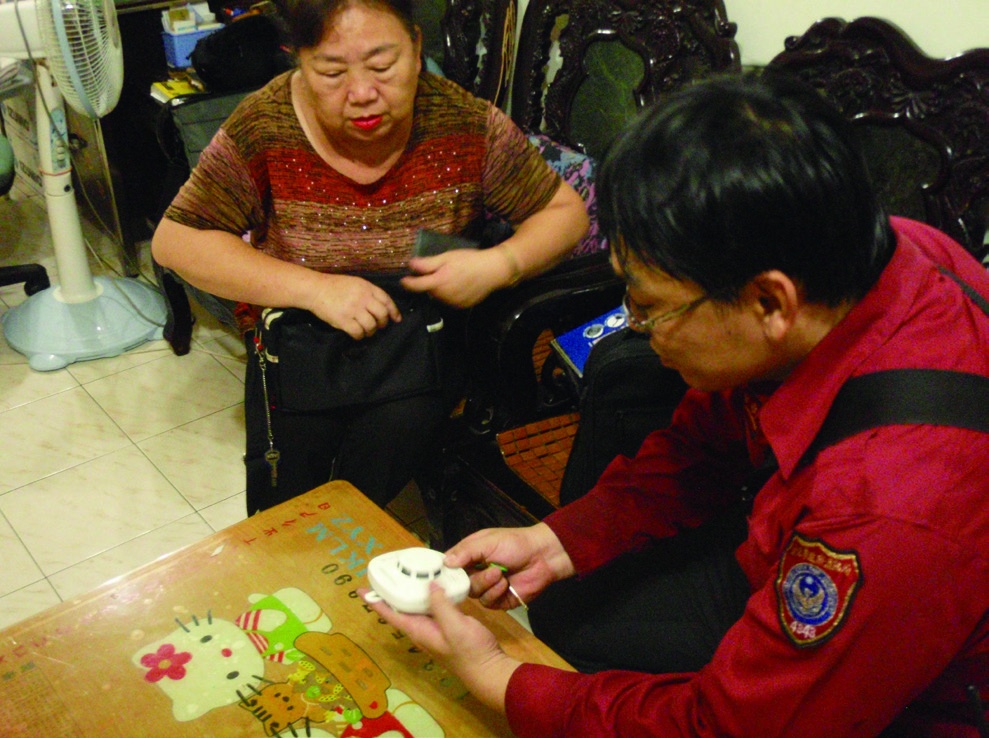 |
| Promoting fire alarm usage in residential buildings |
- Improving Fire Safety in Existing Buildings
The Taipei City Fire Department established “Operations Summary for the Review of Fire Safety Equipment Improvements and Inspections upon Construction Completion in Buildings in Taipei” to improve the functionality of the aging fire safety equipment in existing buildings and to improve fire safety. It is difficult to construct fire safety equipment for buildings of this type, so the parties with the right to manage such buildings may submit proposals to make improvements to their fire safety. When such improvements have been completed and passed inspection, the parties with the right to manage should maintain them according to the approved proposal in order to safeguard the safety and the properties of building residents.
(4) Advertising of Carbon Monoxide Poisoning Prevention and the Financial Aid on Replacing and Relocating the Gas Water Heater
The Taipei City Fire Department established the “Taipei City Government 2013 Prevention of Carbon Monoxide Poisoning and Home Visit Promotion Plan” to educate the public about the selection of appropriate hot water heaters and the importance of ensuring adequate ventilation.In 2013, the Department provided a subsidy of NT$3,000 per household for the relocation of natural gas water heaters in 576 families that were concerned about carbon monoxide poisoning.
3. Disaster Prevention and Rescue
(1) Distributing Disaster Prevention Handbook for Taipei City Citizen
In order to improve city residents’ awareness of disaster prevention, abilities to help themselves and each other, and abilities to react to various disasters so that they will not panic in the face of disasters, the Taipei City Fire Department printed a million copies of Disaster Prevention Handbook for Taipei City Citizen and delivered them to each household to strengthen disaster prevention awareness among the city residents.
(2) Disaster Prevention Mobile APP
In order to enable citizens to access the latest updates on disasters and rescue missions, an official website and an app for smartphones were installed to provide relevant downloadable disaster prevention information. This app offers weather maps, information about typhoons, disasters, rainfall, water levels, images, escapes and escape route planning in addition to location-based information and capabilities to disseminate or broadcast messages.
In 2013, we added functionalities for the public to set locations and inquire about disaster situations in neighboring areas. This system utilizes GIS to display disaster locations, which shows the locations of disaster sites and their distances to the current location of the inquirer. This information serves as a reminder to the inquirer to avoid disaster sites. Additionally, rain intensity is color coded for easy recognition. Education materials on earthquakes, typhoons, fires, and other disasters are also available on the app, and so is information on how to prepare a disaster kit and emergency contacts.
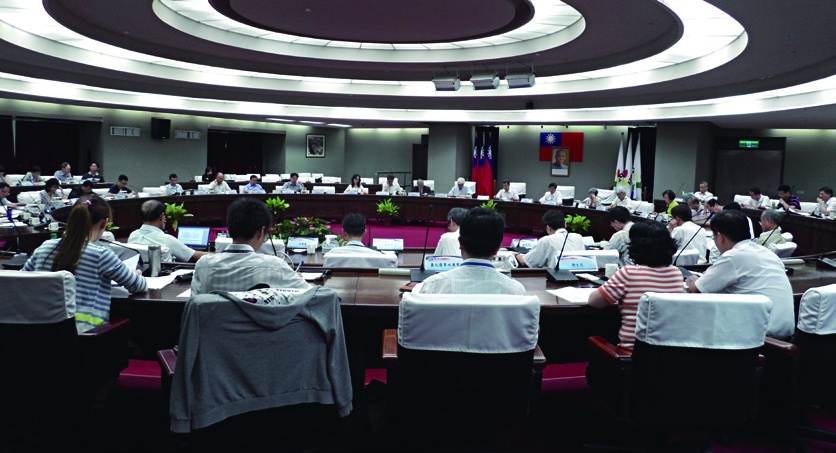 |
| Taipei Disaster Prevention Expert Advisory Committee |
(3) Map of Information Display System
In order to provide the public with integrated disaster information, the government planned for the establishment of the Map of Information Display System, that provides information such as weather, rainfall, water levels, and pumping stations as well as functionalities for printing and GPS. When a warning threshold is reached, the system effectively summarizes and simplifies the relevant information into electronic maps, which it provides to users along with warning messages.
(4) Taipei City Disaster Prevention Expert Advisory Committee
Implementing the authority of Paragraph 3, Article 9 of the Disaster Prevention and Protection Act , the Taipei City established the Taipei City Disaster Prevention Expert Advisory Committee, which chaired by the mayor, who appoints a professional and unbiased person outside the Taipei City Government as the committee vice chairperson. An additional 19 to 25 people may serve on the committee, which is to be divided into six subcommittees, respectively for typhoons, earthquakes, public safety, organizations, information and communications, and medical and hygiene. The committee is to execute the Taipei disaster prevention and rescue policy, recommend measures to be taken, research and develop technologies, and respond to inquiries about the applications of the committee’s work. 12 subcommittees and 2 whole committee meetings were held in 2013.
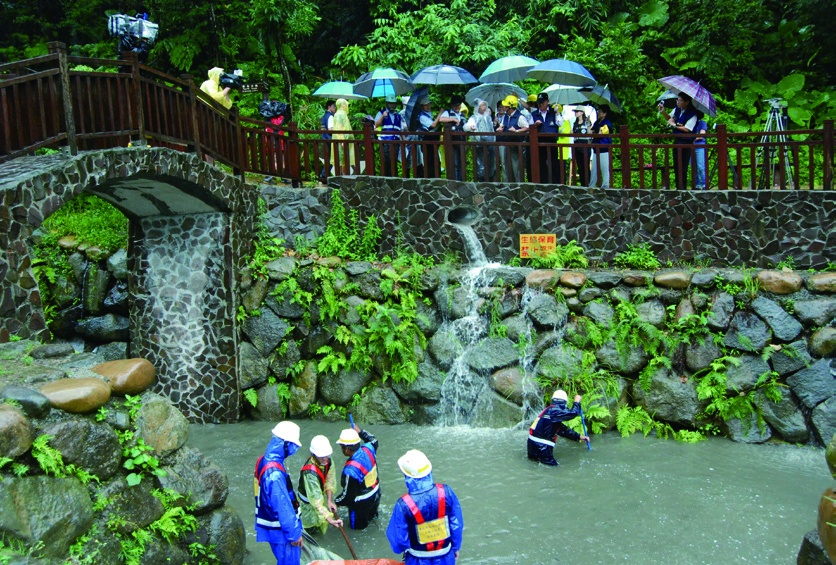 |
| Taipei Disaster Prevention, Resources and Response Supervision Plan |
(5) Implementing the Taipei City Disaster Prevention, Resources and Response Supervision Plan of Government Agencies
This plan was established and executed for continuity during periods when the top-level and the second-level organizations of the Taipei City Emergency Operations Center were being assembled. During that time, it was necessary to understand the levels of preparation and rescue situations at various levels of the emergency operations center, to supervise and monitor the implementation of emergency prevention and rescue measures at various organizational units, and to strengthen the operational efficiency and elevate the capabilities to react and handle situations in the Taipei disaster prevention and rescue system. In 2013, during the Flood on May 11 , the typhoons Soulik and Trami, the Flood on Aug. 23, the typhoon Kong-Rey, the Flood on Aug. 31 , and the typhoon Fitow, the Taipei City Emergency Operations Center exercised its duties in supervising the organization for seven disaster incidents.
(6) Promotion of Disaster Prevention and Drills for Disaster Rescue
- A Fire Safety Day in Taipei Elementary Schools
Beginning in September 2013, we proactively entered the campuses of the 153 elementary schools in Taipei where we taught fifth graders a basic course on disaster prevention; in which having them operate fire extinguishers and indoor fire hoses, putting them through disaster escape drills, CPR, and reporting of disasters. Using hands-on exercises, we trained and elevated the fire safety awareness, techniques, and the schoolchildren’s ability to respond to incidents.
- We held a “119 Expanded Promotion for Disaster Prevention” rally on January 19, 2013, at the Shin Kong Mitsukoshi Chantal Plaza in Xinyi District. The event mainly featured emergency disaster kits, the disaster prevention park, disaster prevention maps, residential fire alarms, and other relevant information.
- In 2013 we held 17 CPR training sessions at the Fire Safety Museum of Taipei Fire Department. A total of 556 city residents attended.
- In July 2013, we held fire prevention camps for young children between 6 and 12 years old. A total of 1,600 children participated in the activity.
- A Series of Activities for the National Anti- Disaster Day
(A) We hosted a drawing event on September 7, 2013, at the National Dr. Sun Yat-sen Memorial Hall for participants to draw or paint about disaster prevention to help them realize its importance. We put up posters at the venue from September 4 to 11 for citizens to see in advance of the event. On the day of the event, we had on-stage programs, Q&A with prizes, information stalls, challenges for participants, and fire engines on display to help participants learn more about disaster prevention.
(B) On September 18, 2013, at Beitou garbage incineration plant, we held exercises for the National Anti-Disaster Day and Complex Disaster Prevention and Rescue Drill for earthquakes and nuclear disasters. It included displays of radioactive equipment, drills for placements in shelters, and drills for earthquakes and nuclear disasters.
(C) On September 13, 2013, we held oneminute earthquake drills at high schools, vocational high schools, junior high schools, elementary schools, and kindergartens in the city.
(D) From July to September, 2013, we held one drill for River Cruises, four drills for the establishment of disaster prevention parks, four drills for multiple disasters in the MRT system, 60 drills for education and evacuations in various villages, and 65 drills for earthquakes and disaster prevention to hone the disaster response capabilities of the departments and units within the Taipei City Government. It was hoped that through such promotions and educational activities we could strengthen the disaster prevention awareness, skills, and selfpreservation capabilities of city residents and reach the goal of disaster prevention by each individual.
- The Taipei 2013 National Defense Mobilization (Wan-an No. 36) and Disaster Prevention and Rescue Drills: To strengthen preparedness, response, and recovery measures in the face of large-scale disasters, to exercise mutual support and cooperation between central and local governments, to improve the quality of evacuations and sheltering, and to foster consensus for disaster prevention among city residents, we planned exercises for disaster prevention and rescue. We held a war game on the morning of March 13, 2013, and the real exercises were executed in the afternoon at the riverside parking lot of Taipei Zoo, Chienkuo Base, and Taipei Lungmen Junior High School. A total of 2,100 people were mobilized, using 205 various vehicles and 4 helicopter sorties.
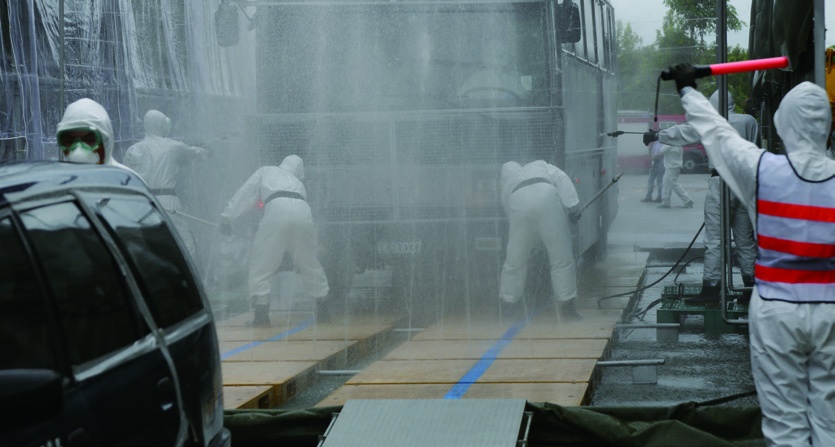 |
| Complex disaster prevention and rescue drills for earthquakes and nuclear disasters |
(7) Out-of-Hospital Emergency Care
- Number of Out-of-Hospital Cardiac Arrest (OHCA) Patients Discharged After Recovery is 442
From its inception on June 1, 1999 to the end of 2013, the Golden Phoenix Emergency Medical Service Team of the Taipei City Fire Department successfully saved 442 OHCA patients, who were later discharged from hospital in good health.
- Implemented Billing for Abusing Ambulance Service
On December 8 , 2012 the “ Taipei City Ambulance Abuse Billing Plan” was implemented. “119” callers who requested an ambulance to travel to non-medical service establishments, and who “failed” to visit the emergency room for injury examinations and registration were billed a service charge of NT$1,800 to cut down on resource abuse. In 2013, “119” emergency calls for ambulance service dropped 3,347 times, or 2.46% lower than the same period last year. 24 emergency line abuse fines have been issued so far, all of which were paid.
- Strengthening Accident Reports of Patients with Cerebral Vascular Accident (Strokes) to Enhance Treatment of Thrombosis
The Taipei City Fire Department and 9 designated emergency hospitals are now taking advantage of out-of-hospital advance emergency notification capability of “119” calls for patients suspected of suffering strokes. 422 cases were notified in 2013, of which 326 were indeed diagnosed by hospitals as strokes, giving rescue workers an overall accuracy rate of 77.25%. Of the 422 notified cases, 68 cases mobilized the stroke teams and received thrombosis treatments, or 16.11%. That effectively cut down on delays of medical care due to transit and transfers and improved patients’ prognosis.
(8) International Exchange Activities
The professional competence of the Taipei City Urban Search and Rescue Team continues to win critical acclaim and recognition by experts in Japan. The team has been invited to take part in the annual “Comprehensive Disaster Training and Maneuvers” in Tokyo for 7 years in a row between 2007 and 2013.
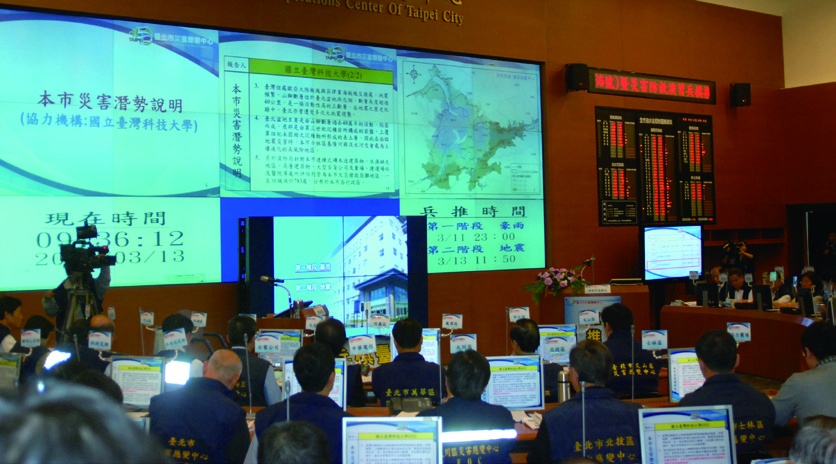 | 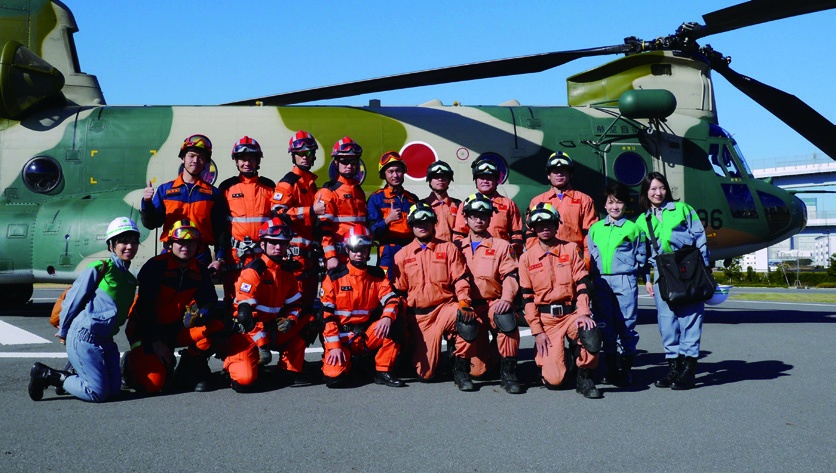 |
| National defense mobilization (Wan-an No. 36) | Rescue team in Tokyo’s Comprehensive Disaster Training and Maneuvers |
Table 1 Taipei City Emergency Operations Center in 2013 | Disaster Response | Time of Operations | Disasters Reported |
| 0511 Flood | May 11, 7:45am to 11:00am | 71 incidents were reported: power blackouts at 2 locations, gas leaks at 1 location, problematic water puddles on road surfaces at 23 locations, flooded houses at 20 locations, landslides (fallen rocks) at 4 locations, roadside trees toppled down at 18 locations, and 3 other types of incidents. |
| Typhoon Soulic (severe) | July 11, 14:00pm to July 13, 23:00pm | 4,141 incidents were reported: 2 seriously injured, 11 slightly injured, 13 houses toppled, power blackouts at 868 locations, telephone outages at 4 locations, gas leaks at 5 locations, city water stoppages at 48 locations, problematic water puddles on road surfaces at 9 locations, flooded houses at 13 locations, landslides (fallen rocks) at 5 locations, road damages at 7 locations, roadside trees toppled down at 1,804 locations, electrical wires (poles) damaged at 232 locations, traffic signal damage at 105 locations, streetlamp failures at 97 locations, signage fell down at 374 locations, fire rescues at 4 locations, and 540 other types of incidents. |
| Typhoon Trami (mild) | August 20, 14:00pm to August 22, 7:30am | 247 incidents were reported: 1 slightly injured, power blackouts at 16 locations, gas leak at 1 location, city water stoppages at 3 locations, problematic water puddles on road surfaces at 30 locations, flooded houses at 21 locations, landslides (fallen rocks) at 8 locations, road damages at 29 locations, roadside trees toppled at 39 locations, traffic signal damages at 15 locations, streetlamp failures at 38 locations, signage fell down at 4 locations, electrical wires (poles) damaged at 7 locations, and 35 other types of incidents. |
| 0823 Flood | August 23, 16:00pm to August 23, 19:30 pm | 116 incidents were reported: problematic water puddles on road surfaces at 76 locations, flooded houses at 12 locations, landslides (fallen rocks) at 3 locations, road damage at 6 locations, traffic signal damage at 2 locations, streetlamp failures at 6 locations, signage fell down at 1 location, and 10 other types of incidents. |
| Typhoon Kong-Rey (mild) | August 28, 17:00pm to August 29, 17:30pm | 10 incidents were reported: power blackout at 1 location, problematic water puddles on road surfaces at 1 location, landslides (fallen rocks) at 1 location, streetlamp failures at 1 locations, signage fell down at 3 locations, and 3 other types of incidents. |
| 0831 Flood | August 31, 22:00pm to September 1, 5:00am | 28 incidents were reported: power blackouts at 4 locations, problematic water puddles on road surfaces at 6 locations, flooded houses at 1 location, landslides (fallen rocks) at 1 location, road damage at 3 locations, roadside trees toppled at 2 locations, traffic signal damage at 2 locations, electrical wires (poles) damaged at 1 location, and 8 other types of incidents. |
| Typhoon Fitow (moderate) | October 5, 14:00pm to October 7, 3:00am | 178 incidents were reported: power blackouts at 18 locations, problematic water puddles on road surfaces at 6 locations, flooded houses at 1 location, road damage at 7 locations, roadside trees toppled down at 47 locations, traffic signal damage at 24 locations, streetlamp failures at 27 locations, electrical wires (poles) damaged at 2 locations, signage fell down at 22 locations, and 24 other types of incidents. |






![Taiwan.gov.tw [ open a new window]](/images/egov.png)
